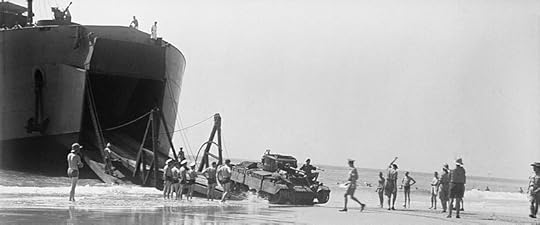Russell Phillips's Blog, page 2
November 20, 2023
Kickstarter: Setting Europe Ablaze

I’m running a Kickstarter for my next book, Setting Europe Ablaze: The SOE Sourcebook.
It was SOE agents that assassinated Heydrich, and they were very important in the battle for Madagascar. The sourcebook will give you everything you need to play similar adventures, and others, such as:
The Kickstarter has already funded, but we’re now chasing stretch goals to enable me to make it a better book.
Back it nowJune 20, 2023
Armourgeddon Review

Last week, I went on a tank driving experience at Armourgeddon in Leicestershire, UK.
The tank driving part was in a turreted FV432, of the type used in Berlin during the 1980s. The British Army converted about thirteen of these vehicles, mounting the turret from a Fox armoured car above the passenger compartment. Armourgeddon has since converted more vehicles, which they use for tank paintball battles. The one I drove was one of the originals that served in Berlin.
I’ve ridden in a tracked AFV before, but this was my first time driving one. There were three of us driving our vehicle, each doing two circuits of the track. I was the last one to drive, so I was in the turret for the first four circuits, with the other two driving.
Our instructor, Alex, was excellent, friendly, and very knowledgeable about the vehicle. I drove one circuit with the driver’s hatch open and my head out, then a second circuit with the hatch down. My visibility on this second circuit was extremely limited, so I was dependent on instructions from Alex, delivered over the intercom. As I completed my second circuit, he asked me how good I was at parking. As the last driver, I had to reverse park the FV432. Still buttoned up, I had no visibility whatsoever of what was behind us. I was completely reliant on Alex’s instructions. Happily, I managed to park between two other vehicles without hitting either of them.
 Sherman M4(105) at Armourgeddon
Sherman M4(105) at ArmourgeddonThe tickets for the tank driving day included entry to the attached military museum, so I spent some time in there. Compared to a site like Bovington, the display is small. Alex told me that, since they can’t compete on size, they focus on acquiring interesting items. I can certainly confirm that they have do this well. The display included items that I’ve not seen anywhere else, including things like Pak 36 and Pak 38 anti-tank guns, plus an M4 Sherman equipped with a 105mm howitzer.
It’s worth noting that they also restore vehicles and weapons. I know that their 88mm flak gun, Sexton, and Chieftain were all restorations. Photos of the original state of the 88 and the Sexton show that they were in a terrible state when Armourgeddon acquired them. Both are now in excellent condition.
I only have one small complaint. The displays were somewhat cramped, which made taking photos difficult. But it was an excellent day, and I can highly recommend a visit.
April 27, 2023
Myth: British government wouldn’t confirm or deny existence of Special Air Service (SAS)

Much of what the British Special Air Service (SAS) does is top secret. This naturally leads to rumours and myths growing up around them. One myth is that the British government refused to confirm or deny their existence, until the dramatic conclusion of the Iranian Embassy siege meant that they were literally broadcast to millions of TV viewers.
The Special Air Service was originally formed during the Second World War, and disbanded soon after the war ended. 21 SAS (formed in 1947) and 23 SAS (formed in 1959) are Army Reserve (formerly known as Territorial Army) units. 22 SAS, formed in 1952, is the only Regular Army SAS unit. The myth is vague about whether it refers to only 22 SAS, or all of them.
Debunking this myth only requires a quick search of Hansard, the official report of all British parliamentary debates. The earliest mention by a member of the government that I could find is from March 1952. The Secretary of State for War, Anthony Head, states unambiguously that “It [Special Air Service Regiment] is in existence today“. It’s not specified, but given the date, he’s probably referring to 21 SAS, then part of the Territorial Army.
The myth tends to be vague, but it might only refer to 22 SAS, the Regular Army regiment. The earliest mention of 22 SAS that I could find is from July 1959. The Under-Secretary of State for War, Hugh Fraser, says that British forces, including the Special Air Service Regiment, assisted the Sultan of Oman’s armed forces between December 1958 and February 1959. He doesn’t specify which SAS unit he is referring to, but 22 SAS was the only one deployed to Oman.
Another variant of the myth is that the government has never admitted deploying Special Air Service troopers to Northern Ireland during the troubles there. Once again, Hansard proves this to be false. In January 1976, none other than Prime Minister Harold Wilson referred to the Special Air Service in Northern Ireland. He clearly states that “… the SAS will be employed and deployed … in dealing with all the problems of terrorism in the area.“
The British government are often coy about exactly what the SAS do and how they do it, but they’ve never been shy about the unit’s existence.
March 6, 2023
Primary sources on the Internet Archive

In my research, I sometimes photograph or scan primary sources. Up until now, they’ve sat on my hard drive, inaccessible to anyone else. On occasion, someone has asked me for a document, and I’ve been happy to send it to them. I’ve started uploading these documents to Internet Archive, to make them generally accessible to anyone that is interested in them.
Thus far, I’ve uploaded all thirty-one issues of Army Technical Intelligence Review that I have. This is a specialised British Army magazine, and although they aren’t mentioned, I’m reliably informed that at least some of the intelligence contained came from BRIXMIS. There are also some documents about the 1980 Iranian Embassy siege, a Second World War British War Office pamphlet about the Far East and Madagascar campaigns, and a war diary.
I shall upload more as I get time, but it’s likely to be a slow process. Everything that I have uploaded can be found on my upload page.
February 1, 2023
New RPG Book: The Epiphany Club and the Great Library of Alexandria

My latest book is a steampunk RPG campaign for use with RISUS: The Anything RPG.
The CampaignWelcome to the Epiphany Club, where the pursuit of knowledge and adventure is the name of the game. A Victorian gentlemen’s club with a difference, its distinguished members are determined to solve some of the world’s greatest mysteries.
For centuries, the wonders of the Great Library of Alexandria have been considered lost forever. So when the club discovers a clue to its whereabouts, the race is on to discover this forgotten treasure first.
In this exciting steampunk campaign, you will play a member of the Epiphany Club, travelling across Europe and Africa to find the Great Library of Alexandria. But with so many people desperate to get their hands on the knowledge contained within the library’s hidden walls, your mission will be far from smooth sailing.
Will you gather all the clues and solve them in time? Or will they merely lead you on a risky wild goose chase?
Your quest will take you on a high stakes adventure where danger and betrayal lurk round every corner. You’ll encounter an array of interesting characters, but not everyone is who they say they are. There’s a network of spies, criminals and even ninjas to contend with, so you’ll need to stay calm and keep your head if you want to reach your goal.
Will you be the one to uncover one of the most famous wonders of the ancient world? Or will you be beaten to the discovery by someone hoping to get hold of the priceless historical artefacts for their own motives?
January 16, 2023
Lessons learned at Madagascar

Whenever there is a discussion around Operation Jubilee, the Dieppe raid, someone will claim that it taught the Allies valuable lessons about amphibious operations. There’s no doubt that this is true, but the implication is that without Dieppe, later operations would not have succeeded. This is a huge “what if”, and of course there’s no way to prove or disprove it. It’s notable that the people making these claims ignore, or are unaware of, the successful amphibious operations at Madagascar. The first of these took place fourteen weeks before the raid at Dieppe.
The Allies learned valuable lessons at Dieppe, but ignoring the lessons learned at Madagascar does a huge disservice to the men who fought and died there. Simply conducting a successful long-term invasion, as opposed to a short-term raid, provided valuable experience to all involved. It also gave the Allies confidence that they were capable of such a feat. This article will detail some lessons that the Allies learned at Madagascar and put into practice in later operations.
Combined Operations Pilotage PartiesThe lack of intelligence regarding the landing beaches led to problems landing men and vehicles. Recognising this, the Allies formed Combined Operations Pilotage Parties (COPPs). Their role was to reconnoitre enemy beaches before an assault. As well as locating defences, they determined whether the beach was suitable for landing tanks and other vehicles.
Mobile Operational Naval Air BaseExperience of using carrier-borne aircraft to support the operations led to the Mobile Operational Naval Air Base concept. The Royal Navy put these to good use in the Pacific theatre during 1944 and 1945.
 Valentine tank disembarking from BachaqueroTank Landing Ships
Valentine tank disembarking from BachaqueroTank Landing ShipsThe new Tank Landing Ship (LST) concept was first used during Operation Ironclad, the initial invasion of Madagascar. It proved the concept, but also highlighted a shortcoming. Bachaquero, the LST used in Ironclad, struggled to reach the beach to discharge her cargo. Her captain dealt with the problem, but the experience led to the development of causeways that were carried on the ships. If the ship could not reach the beach, the causeway would be deployed and use that to convey cargo to the beach.
Deception and SurpriseThe British used various techniques to deceive the French on Madagascar as to the naval convoy’s final destination. When the initial invasion started, they made further efforts to confuse the local commander as to the location of the invasion. HMS Hermione conducted operations against ground targets on the east coast in apparent support to an invasion, while Swordfish dropped dummy paratroopers inland. Because of these efforts, the Vichy commander sent his only mechanised force in completely the wrong direction.
Surprise was a major factor in the success of the initial landing. The British War Office suggested that in future operations, leading formations should concentrate on exploiting deep into enemy territory, leaving follow-up units to secure the beaches. This would spread the threat to the enemy, providing greater security to later forces than a covering screen.
Use of White Flags and LeafletsThe British hoped that the true loyalties of the French on the island lay with the Free French and the Allies, not Vichy and the Germans. They flew white flags and aircraft dropped leaflets to persuade the locals that the Allies were liberators, not conquerors. They didn’t work. Indeed, Admiral Syfret’s report noted that, “Stories of what the inhabitants did with the leaflets would surprise their originators.”
For much more about the battle for Madagascar, see my book, A Strange Campaign.
October 17, 2022
The Value of Diverse Interests

A while ago, I received an email from someone that had read A Ray of Light. It’s always a pleasure to get an email from a reader, but this one was a little different. The reader, Meg, was about to start the final year of her undergraduate degree at Durham University. Her dissertation is about the concept of “places of memory”, and she was intending to focus on Lidice.
We arranged to meet so that she could ask me some questions about the story of Lidice, and my opinions on certain aspects of the story and remembrance. The resulting conversation was fascinating. My background is military history, and I’ve been interested in the Second World War since I was a child. That naturally informed the way I approached the story of Lidice and Stoke-on-Trent. Not being a military historian, Meg approaches it from a completely different angle. Because of this, she asked questions that I hadn’t considered, and probably never would have. As well as Lidice specifically, We talked about remembrance and commemoration in general, and she challenged my ideas on some things.
I’ve written before about the importance of diversity. Then, I was referring to diversity of gender, race, etc. But the meeting with Meg was an example of the value of another kind of diversity — that of specialism. Military historians looking at a given subject will generally reach similar conclusions. But someone with a different interest will see things that the military historians miss, and will consequently ask new questions, revealing new insights. This can only be a good thing for the discipline and for our understanding of history in general.
October 3, 2022
Deal of the Day: A Ray of Light

The ebook of A Ray of Light, my book about Heydrich and Lidice, is DriveThruFiction’s deal of the day. For the next twenty-four hours only, it’s discounted by 60%
Get it nowSeptember 14, 2022
New RPG book available for pre-order

My next book is an RPG book. A steampunk RPG campaign for use with RISUS: The Anything RPG, it was funded on Kickstarter.
Kickstarter backers will get their copies later this year, but it is now available for everyone else to pre-order at certain stores.
The CampaignWelcome to the Epiphany Club, where the pursuit of knowledge and adventure is the name of the game. A Victorian gentlemen’s club with a difference, its distinguished members are determined to solve some of the world’s greatest mysteries.
For centuries, the wonders of the Great Library of Alexandria have been considered lost forever. So when the club discovers a clue to its whereabouts, the race is on to discover this forgotten treasure first.
In this exciting steampunk campaign, you will play a member of the Epiphany Club, travelling across Europe and Africa to find the Great Library of Alexandria. But with so many people desperate to get their hands on the knowledge contained within the library’s hidden walls, your mission will be far from smooth sailing.
Will you gather all the clues and solve them in time? Or will they merely lead you on a risky wild goose chase?
Your quest will take you on a high stakes adventure where danger and betrayal lurk round every corner. You’ll encounter an array of interesting characters, but not everyone is who they say they are. There’s a network of spies, criminals and even ninjas to contend with, so you’ll need to stay calm and keep your head if you want to reach your goal.
Will you be the one to uncover one of the most famous wonders of the ancient world? Or will you be beaten to the discovery by someone hoping to get hold of the priceless historical artefacts for their own motives?
July 8, 2022
The Bear’s Claws: Audiobook

I’m pleased to say that The Bear’s Claws is now available as an AI-narrated audiobook. It’s over eleven hours long, but using AI narration means the price is the same as the ebook: only £2.99
The AI narration is surprisingly good. You can listen to a sample here.
Get it now at Google Play, Wargame Vault, Kobo, or buy direct.



